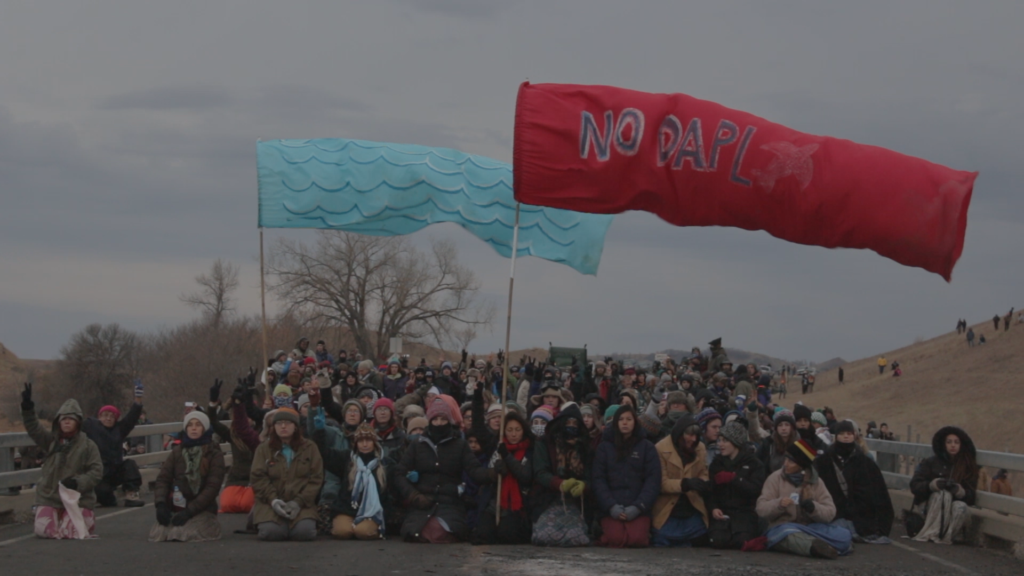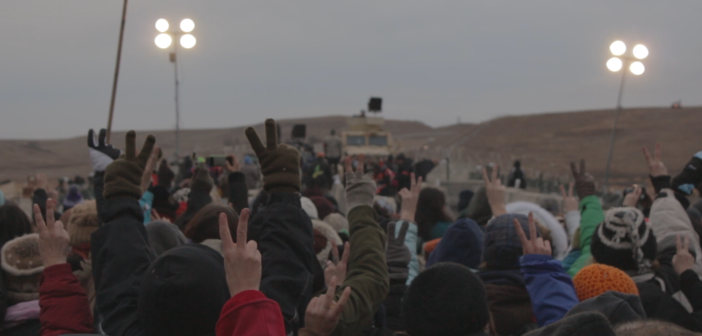When is resistance futile, and when is it an effective tool for change?
Throughout history and across the globe, women, people of color, and other marginalized groups have resisted against the abuse of power. The film exhibition List Projects: Civil Disobedience, which ran July 18 through October 29 of 2017 at MIT’s List Visual Arts Center, invited us to take a look back at how we’ve resisted — sometimes successfully, sometimes not — at historical turning points: the Vietnam War, the Civil Rights Movement, Women’s Liberation, and the Gay and Gender Rights movements, to name a few. By way of a continuous loop of historic to recent film footage, viewers had the opportunity to see civil disobedience not just as a phenomenon, but also as a universal truth: we resist because we must. While the exhibition has passed, two stand-out films (viewable via YouTube) give us a sense of how women in particular have confronted that struggle: Third World Newsreel’s Up Against the Wall, Ms. America, 1969, and Paper Tiger Television’s Standing Rock Women’s March, 2016.
On November 26, 2016, in Standing Rock, North Dakota, indigenous women and their allies peacefully marched across Blackwater Bridge in response to the treatment of protesters of the Dakota Access Pipeline. The previous week, police shot tear gas and rubber bullets, launched concussion grenades, and sprayed hoses at protesters in sub-freezing temperatures. Although anger-fueled actions would have been warranted, the protesters deployed a more powerful counter resistance: their peaceful presence, and their resilient compassion.
The marchers processed to the bridge, vibrant “Protect the Sacred” banners dancing in the wind, and were met by coils of barbed wire and cement roadblocks. They stopped, lit a bowl of sage, and stood silently. Their spokesperson addressed those gathered from a megaphone: “When you unify spirits with peace and love, there is no stopping us. There is no victory and there is no loser. There is only the stand that we make for peace. So in that way we are free already. We have not become overcome.”

Still from Standing Rock Women's March. Image courtesy of Julie Ludwig, Paper Tiger Television.
Her words reached back generations and through nations and epochs to once again reveal the one power that is indestructible: the power to not respond with hate, but with love. Gandhi, Martin Luther King, Mother Teresa, and many others have changed the course of history through their own peaceful acts of resistance; the women of Standing Rock understood this as an enduring answer to the threat of violence.
Women, our nation’s largest marginalized group, have resisted inequities and oppression at pivotal points through our nation’s history. But during the 1960s Women’s Liberation Movement, women — specifically, white women — were arguably privileged enough to be more fervent in their activist tactics. In Up Against the Wall, Ms. America, an announcer with a megaphone introduces a sheep as the winner of the 1968 Miss America contest in a darkly humorous parody of the pageant’s sexism. “When my master sees that he is about to lose his slave, man, he gets uptight!” she says. The film was at once cheeky and ominous: many women see themselves in the cardboard cutout figure of a woman that was paraded about in the film—or at least they see that it has been far too easy for women to become accessories to men.
Today, women would be reluctant to use slavery references, and they should be: racism is still a palpable part of American culture and institutions, and is finally being addressed as contemporary feminist circles become aware of the exclusionary feminisms of generations past. White feminists, who have been called out for not addressing these tensions, have begun to strengthen their ideals and practices by widening the circle, and women of color continue to form their own coalitions of resistance.
One of the key differences between the women in Up Against the Wall and those who protested at Standing Rock is that white women in the 1960s had at least some autonomy while women of color were facing far more oppression from both sexism and racism—a trend that continues today. Women, in particular white women, were finally beginning to see the possibilities of true independence and choice — which many women today have taken for granted.
By contrast, as a severely marginalized minority, the indigenous peoples of Standing Rock have no viable recourse in maintaining a sacred trust with their land. The US government has a long and consistent history of breaking promises and treaties to the Indigenous peoples. And yet the film reached deeply into the heart and soul of humanity at its best, despite the fact that Indigenous women continue to be horrifically and systematically abused. As Mary Kathryn Nagle points out in her essay Nasty Native Women, “…Native women and children are more likely to be raped, murdered, and/or abused than any other population in the United States.”¹

Still from Standing Rock Women's March. Image courtesy of Julie Ludwig, Paper Tiger Television.
In these two relatively brief films—each less than ten minutes—we see women resist both the overt and insidious abuse of power. As an act of civil disobedience, the Standing Rock march offers a starkly poignant stand against what is so clearly an act of brutality permitted by the US government. Indeed, the stark, windswept landscape calls to mind Wounded Knee, another in a long list of measured acts of cultural and spiritual genocide against Indigenous American peoples: clearly, some things have not changed. But while one could easily argue that a peaceful protest has almost no impact, in fact the opposite has proven to be true: at least until the Trump administration, Standing Rock protesters successfully kept the pipeline at bay.
What we are coming to realize, whatever our gender, racial, ethnic, or sexual identity, is that if we don’t resist, the abuse of power will persist. If we are complacent, there are men (and some women) who would take us back to a darker time. List Projects: Civil Disobedience offered a sweeping view of how we protest and resist, reminding us that we must once again decide as a nation who we are and how we want to exercise power. This exhibition reflects what one hopes is an ongoing exploration of political resistance through art.
For instance, we can see this subject being further examined at the Fuller Craft Museum in Brockton. Now through February 18, the exhibition Threads of Resistance confronts head-on the Trump Administration and its divisive actions. The Artist’s Circle collective, who conceived the project, issued the following statement: “Our art explores our emotional responses to these actions, in the hope that it will encourage civilized, constructive conversation and, ultimately, better understanding of one another’s viewpoints.”
Exhibitions such as these are of the moment for two reasons: First, in the United States, given the divisive and anti-nurture policies of the Trump administration, many have been galvanized who might not have spoken otherwise. Complacency is a potent and soporific drug, but today, more Americans than ever before see what is at stake for themselves, for their families, and for others they believe should be protected — such as women who took for granted their right to a safe abortion if that was their choice, or the Dreamers whose families and livelihoods will potentially be torn asunder if the Trump administration has its way. Indigenous peoples have been marginalized ever since their land was colonized by white settlers, and as such have never had the privilege to be complacent. And now, after so much has already been taken away, again they are faced with threats to their health and sovereignty. The mandate of art is to reflect the times: and no doubt our cultural institutions will continue to do so — now more than ever.
¹ Nasty Women, Picador: New York, 2017, Samhita Mukhopadhyay and Kate Harding, eds.




